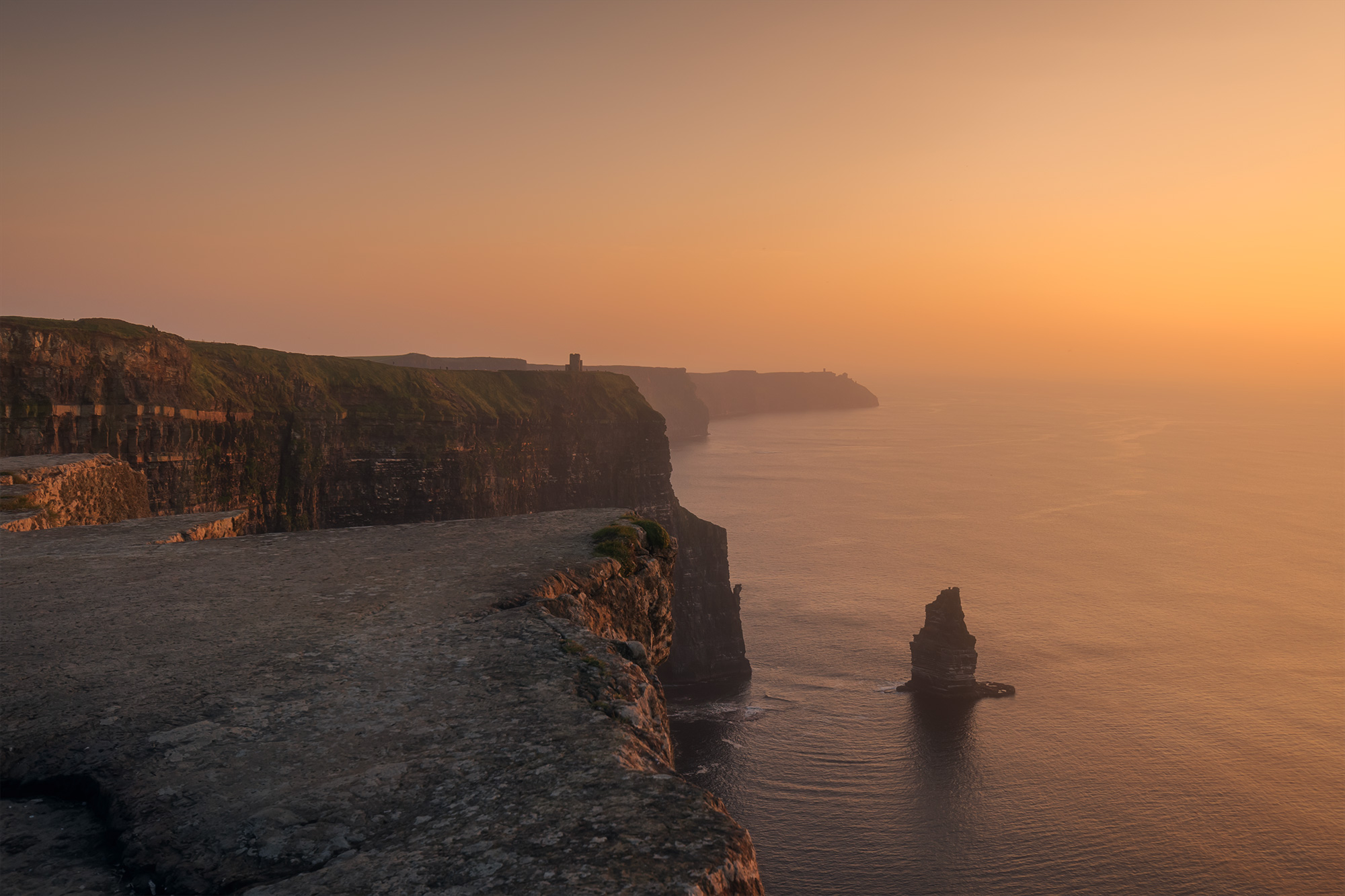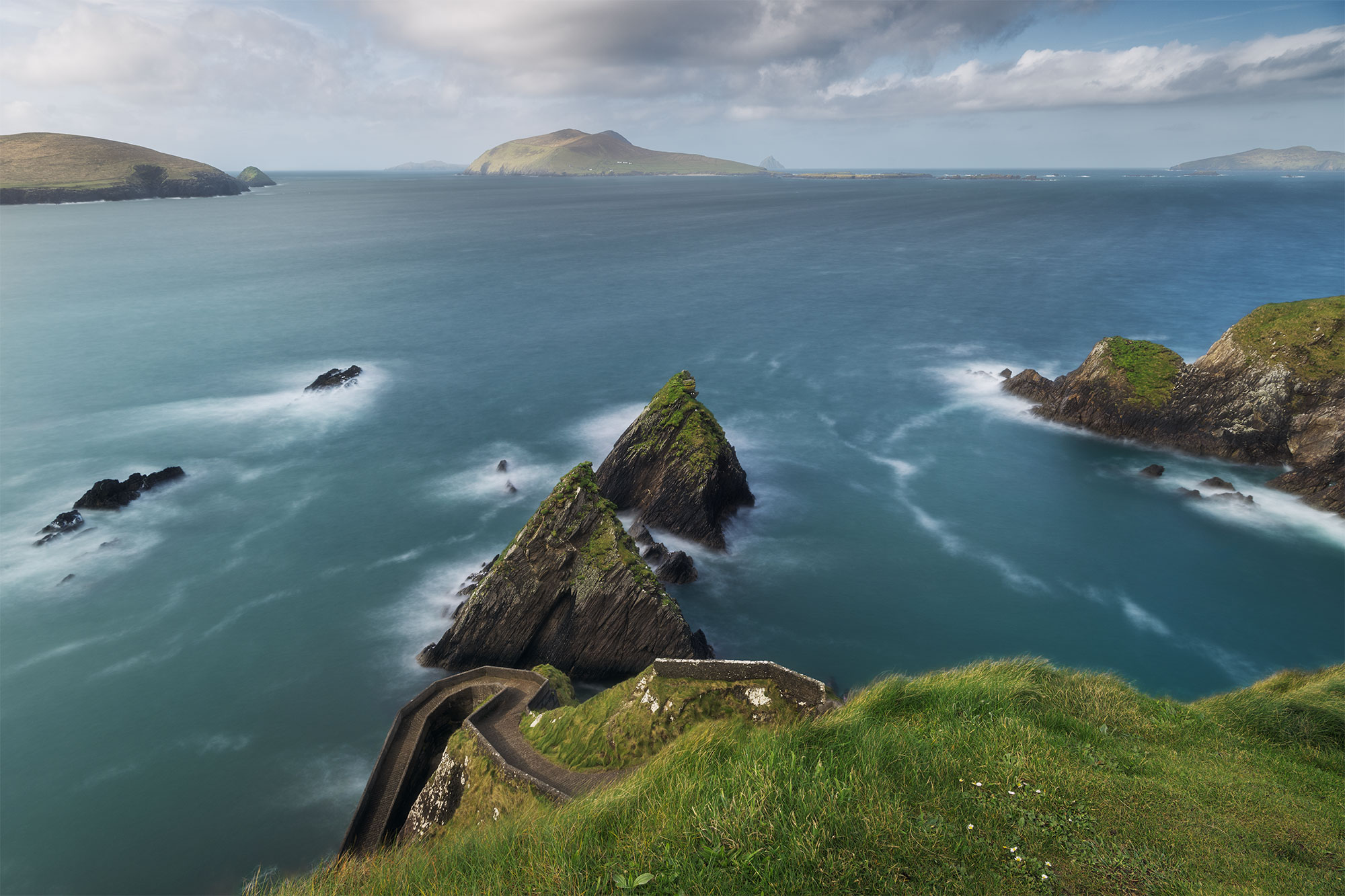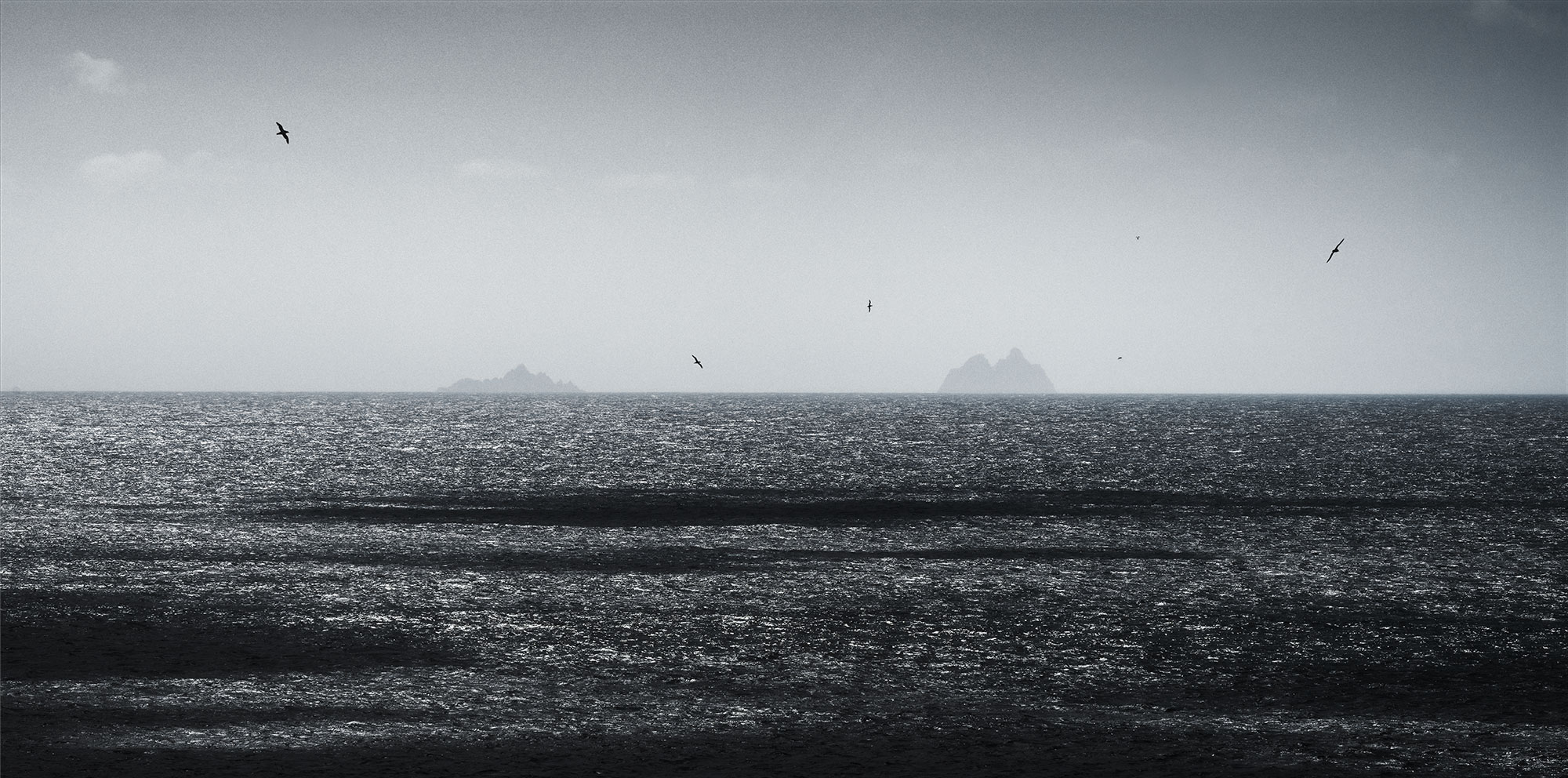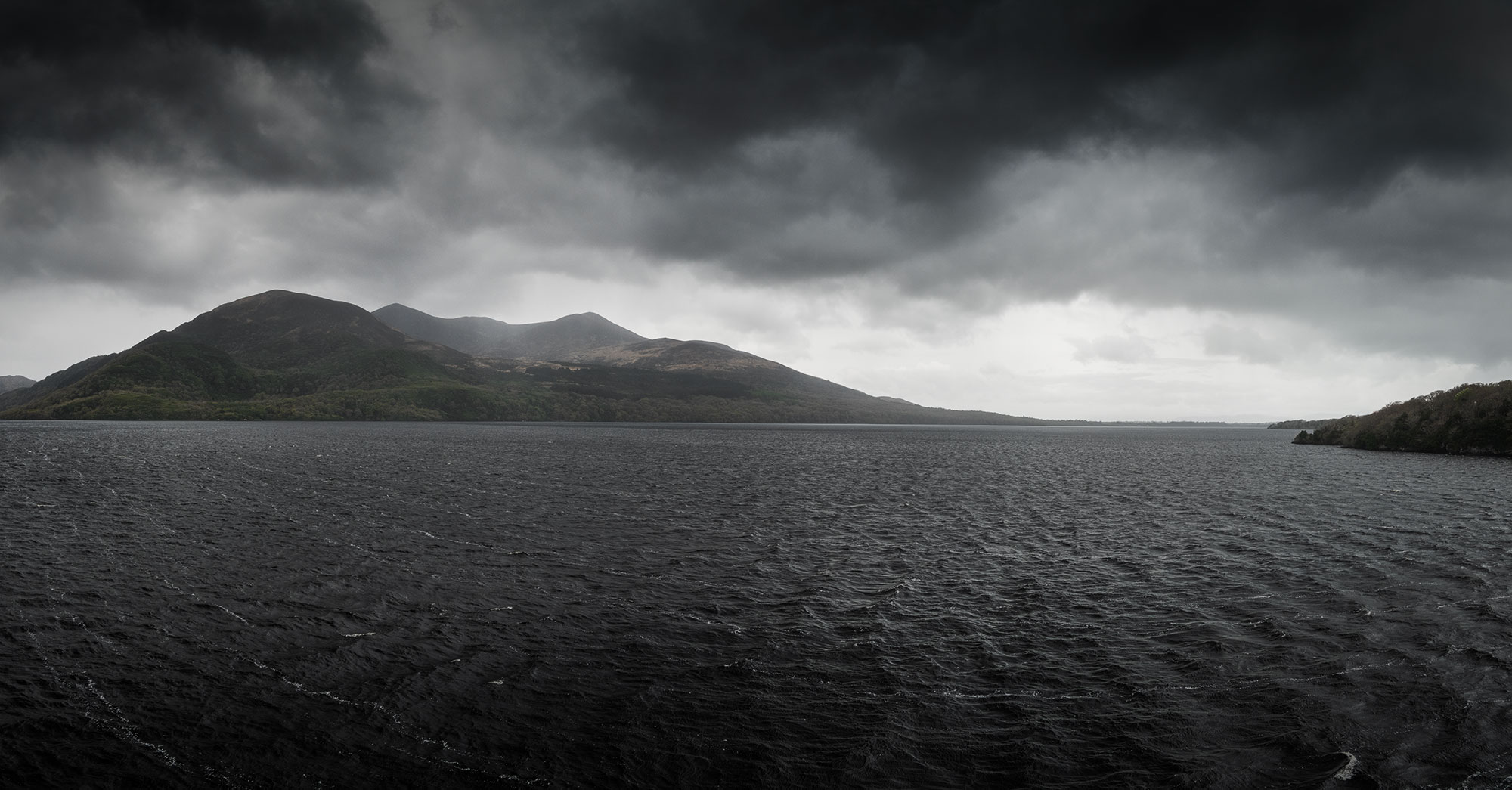Wild Atlantic Way photography is a journey through stormy skies, emerald cliffs, lonely piers, and fog-wrapped lakes. Ireland offers everything a landscape photographer dreams of. While less talked about than Iceland or Scotland, this island reveals its magic to those who dare brave its winds and changing skies.
The Wild Atlantic Way, a 2,500 km coastal route along Ireland’s west coast, is home to some of the country’s most photogenic places from the iconic Cliffs of Moher to hidden gems like Dunquin Pier and Conor Pass. Along this route, you’ll find drama, softness, and silence, often all in the same day.
In this article, I share 5 of my favorite landscape photography locations in Ireland. Each one includes how to get there, how I took the photo, and the exact camera settings I used, so you can prepare your own photo adventure.

1. Cliffs of Moher – capturing sunset at Ireland’s most iconic cliffs
The Cliffs of Moher are among the most photographed landscapes in Ireland and for good reason. Towering 214 meters above the Atlantic Ocean, they offer a breathtaking mix of drama and serenity, especially at sunset when the cliffs catch the last golden light. I’ve visited them twice, ten years apart, and each time felt just as humbling.
How to get there
The cliffs are about a 3-hour drive from Dublin. I started my walk at the Cliffs of Moher Experience, which includes a large paid car park and a visitor centre (admission: €12). You can explore the cliffs from either direction, but I recommend walking at least 20 minutes away from the main area to find quieter, more photogenic spots.
➜ Cliffs of Moher Visitor Centre
➜ Cliffos of Moher information
How I photographed this scene
This image was taken in 2010, before a safety wall was added to limit access to the edge. The weather that evening was calm: no wind, no rain, just the promise of a clear sunset.
I chose to frame both the Sea Stack and the O’Brien Tower in the distance. To enhance the composition, I placed my camera low to the ground to include the flat rock in the foreground, creating a natural leading line across the frame. The Sea Stack felt like the main character of the scene, and I wanted it to stand out boldly against the ocean.
My gear
✅ Nikon D810
✅ Nikkor 12–24mm f/2.8
Camera settings
ISO 160 — f/13 — 1/160s

2. Dunquin Pier – Iconic Viewpoint on the Dingle Peninsula
Dunquin Pier (Cé Dhún Chaoin) is one of the most photographed spots on the Dingle Peninsula. Its narrow zigzagging road, dramatic cliffs, and pyramid-shaped rocks make it a dream subject for landscape photographers. Overlooking the Blasket Islands, it’s the kind of place that looks like it belongs in a painting, especially in moody Irish light.
How to get there
Dunquin Pier is located in County Kerry, at the northern end of a small bay. It’s easy to access by car, with a small parking area just a few metres from the viewpoint. A short path through the grass leads directly to the spot above the pier. Be mindful that this location is popular, so early mornings are best for quiet light and fewer visitors.
How I photographed this scene
On my first attempt, the weather was too rough, torrential rain covered my lens before I could even set up. Determined to get the shot, I returned the next morning under lighter skies.
I had a clear vision: a long exposure to blur the sea and enhance the curve of the pier. But the wind was intense, and even with a tripod, stability was a challenge. I ended up taking two photos: one long exposure for the water, and a shorter one for the grass and sky. Later, I blended both in Photoshop to create the image I had imagined probably my favorite from Ireland.
Camera settings
✅ Nikon Z8
✅ Nikkor 24–70mm f/2.8
✅ Hoya ND1000 filter
✅ Manfrotto tripod
My gear
ISO 160 — f/22 — 30s

3. Skellig Islands – A Misty Glimpse from Dunmore Head
The Skellig Islands, a UNESCO World Heritage Site off the coast of County Kerry, are shrouded in history and mystery. Though best known today for their appearance in Star Wars: The Force Awakens, they were once home to monks who lived in solitude atop the steep rock. The islands are only accessible by boat, but you can spot them from the mainland, if the weather allows it.
How I photographed this scene
I didn’t have the time to take the boat out, but during a hike at Dunmore Head, I kept glancing toward the horizon, hoping to catch a glimpse of the islands. Then, just as the fog began to shift, their silhouette slowly emerged, like a ghost floating above the sea.
They looked tiny in the distance, so I used a telephoto lens to compress the scene. Seabirds were circling overhead, so I took multiple shots to include a few birds in the sky, a detail that felt important to this isolated, wind-swept location.
My gear
✅ Nikon Z8
✅ Nikkor 70–200mm f/2.8
Camera settings
ISO 250 — f/13 — 1/2000s

4. Conor Pass Waterfall – Misty Light on the Dingle Peninsula
The Conor Pass is one of the highest mountain passes in Ireland, offering dramatic views across the Dingle Peninsula. Just ten minutes from Dingle town, it winds between steep cliffs, wild moorland, and hidden streams. On clear days, you can see all the way to Brandon Bay. But during my visit, fog and rain turned the landscape into something much moodier and even more photogenic.
Hidden beside the road, a small waterfall caught my eye. The mist made it look much taller than it really was, and the soft light gave it a mysterious feel that I couldn’t resist photographing.
How to get there
The waterfall is located right beside the main road crossing Conor Pass, between Dingle and Kilmore. There’s a small parking area next to the roadside, just pull over, and you’re there. It’s one of the easiest photo stops you’ll find on the peninsula.
How I photographed this scene
I love using long exposures to create a sense of calm in waterfalls, and this was no exception. The fog was thick that day, but it helped simplify the composition and eliminate background distractions. I used a polarising filter to remove surface reflections on the water, and positioned the tripod to isolate the cascade against the dark rocks.
My gear
✅ Nikon Z8
✅ Nikkor 24–70mm f/2.8
✅ Hoya polarising filter
✅ Manfrotto tripod
Camera settings
ISO 50 — f/18 — 0.6s

5. Lakes of Killarney – Capturing Stormy Light from Ross Island
The Lakes of Killarney, nestled in Killarney National Park in County Kerry, offer a peaceful yet dramatic landscape. Surrounded by forests and framed by mountains, they are among the best lake photography locations in Ireland. The largest of the three, Lough Leane, features islands, reflections, and landmarks like Ross Castle and Ross Island, where I took this photograph just before a storm rolled in.
➜ Lakes of Killarney information
How to get there
To reach this viewpoint, head to Ross Castle, just outside the town of Killarney. From the car park, follow a well-maintained trail through the forest to Ross Island. After about 15 minutes of walking, you’ll find open views across the lake and towards the mountains, perfect for panoramic shots.
How I photographed this scene
The sky was turning darker by the minute, and I knew the rain would soon arrive. I hurried to the viewpoint, took out my Nikon Z8, and managed to fire off 10 vertical handheld shots before the wind pushed the rain sideways across my lens. I later stitched them into a panoramic image capturing the last dramatic light before the weather fully closed in.
Despite the rushed conditions, I loved the contrast between the dark sky and the quiet lake. Sometimes, it’s the short moments that give the strongest results.
➜ Photo spot
My gear
✅ Nikon Z8
✅ Nikkor 24–70mm f/2.8
✅ Hoya polarising filter
✅ Manfrotto tripod (not used here)
Camera settings
ISO 500 — f/10 — 1/160s
Panorama made of 10 vertical photographs
The Wild Atlantic Way, Wild and Worth It
Photographing landscapes along Ireland’s Wild Atlantic Way is an adventure in itself, a dance between light and rain, between patience and spontaneity. Each of these five locations offered something unique: raw cliffs, soft rain, silent lakes, and wind-sculpted coastlines.
What stayed with me most wasn’t just the beauty of the scenery, but the feeling of being part of something bigger, something constantly changing like the sky before a storm or the sea at high tide.
Whether you’re planning your first photo trip to Ireland or returning for more, I hope these stories, tips, and settings help you prepare and inspire you to chase the light in your own way.
Published on July 6, 2024 by Jennifer Esseiva



